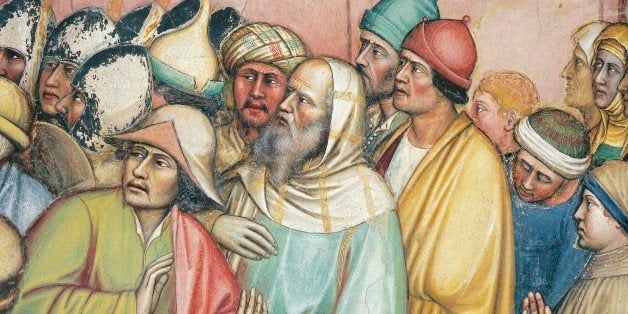
Don't yawn, but my training is in medieval canon law. And, yes, this is almost the ultimate sub-specialty (I have a special admiration, though, for those who do cuneiform legal studies). In my own work, I have focused in books and articles on a group of canon lawyers who flourished in the period roughly between 1200 and 1500.
Even working in a field that seems so old and dry, every so often you have the opportunity to stumble upon a text that is utterly unexpected. And that happened to me a while back when I was reading the work of a 13th century canon lawyer named Hostiensis. I was studying his definition of marriage. As was typical of Hostiensis, he went on for some pages. I worked my way patiently through his qualifications and distinctions. And then I stumbled upon -- and that is the right expression -- a question that seemed to leap off the page.
"May a man marry a man?" Hostiensis asked. No, Hostiensis was not about to open any progressive doors. This was the 13th century, after all. In fact, his answer may have set in motion many of the arguments we encounter today against same-sex marriage. What was remarkable was that he asked the question at all. My only explanation remains that he was a very bright man and he was showing off. He was going to ask a question that no one had ever thought to raise.
His response had two aspects to it: He both proposed arguments meant to explain heterosexual marriage and arguments that amounted to an intensely homophobic attack on same-sex unions. He began with creation. In the beginning, Hostiensis paraphrased Scripture, God made Adam and Eve, a man and a woman. He endowed them with reproductive capacity. And marriage must follow this divinely-mandated design. Male and female were "correlated" with one another. To use the modern ecclesiastical vocabulary, they were "complementary."
Furthermore, Hostiensis continued, marriage constituted a sacrament. It was a sign, a symbol, an instrument of grace. What it symbolized chiefly, he asserted, was Jesus's marriage to his Church. Jesus is male. The Church is female. Jesus, in coming to earth, in shedding his blood, in giving his life, co-mingled his essence with the Church. And this co-mingling could only be represented where a man married a woman, not another man.
Hostiensis, however, was not content to rest his argument there. He next veered in a viciously homophobic direction. Philosophers, Hostiensis's contemporaries, were then engaged in an exploration of the nature of sexuality. And they had concluded that there could only be one form of proper sexual intercourse: It had to be between a man and a woman, and it had to be open to at least the theoretical possibility of procreation. No strange positions. No coitus interruptus. No oral intercourse, or anal intercourse. No potions that had the effect of inducing sterility. No masturbation. Any form of sexual expression, except heterosexual sex open to procreation, was criticized as unnatural.
Hostiensis borrowed heavily from this philosophical current to make even more extreme homophobic claims. Indeed, he was prepared to advance one of the most hostile, homophobic suggestions I have encountered in a medieval text when he looked to a passage of Roman law, promulgated by two early Christian emperors, Constantius and Constans.
That text denounced men who "destroy the proper place of sex" and "criminally love that which confers no advantage." The two emperors recommended in such instances that the law should "arise and arm itself with the avenging sword of right and subdue these infamies with exquisite penalties." In plain language, these two Roman emperors called for the death penalty for gay sexual relations. I have read a number of medieval authors on marriage and sexual relations, and some of them said some pretty outrageous stuff. But Hostiensis's apparent approval of this passage of Roman law counts among the more extreme texts.
The discussion did not stop with Hostiensis. Later authors took up the theme of same-sex unions, the most important being the mid-15th century Bishop Antoninus of Florence. A word about Florence in the 15th century: It was known throughout Europe for its gay culture. For sure, to say that Florence had a gay culture does not mean that it resembled modern urban centers. Florence's gay culture was smaller, forced to go underground because of the steady criminal prosecutions brought against those who violated the city's strict sexual code.
There is no evidence that I can detect suggesting that same-sex marriage occurred in Florence. Nevertheless, it is interesting that it is the Bishop of Florence who revived Hostiensis's preoccupation with same-sex unions. Antoninus's treatment of the subject was far more steeped in biblical theology than Hostiensis's. He deconstructed the passage in Genesis, repeated by Jesus, that in marriage "a man shall leave his mother and father and be joined to his wife and the two shall become one flesh." Antoninus waxed large on this topic. Marriage was this much, he insisted, and much more, since it was also a joining of souls united in the shared endeavor of procreating the next generation.
Same-sex relations violated this expansive biblical understanding. Men who unite with men, women who unite with women, cannot become "one flesh" in the way the Bible understood it. And if they cannot become one flesh, then, Antoninus went on, their actions were in defiance of the divine plan and so must be considered "indecent" and "disgraceful."
Like Hostiensis, Antoninus could fall into truly brutal homophobia. "Sodomy," he asserted, was the greatest sexual sin -- more offensive even than forcible rape. It robs its partakers of everlasting salvation and has even caused the fall of empires.
These arguments, first articulated by Hostiensis, embellished upon by Antoninus, continue to be reasserted today. Marriage justified on the basis of the divinely-intended uniqueness of male/female complementarity remains a staple of Catholic doctrine. And right-wing politicians, even some former candidates for the Republican nomination for president (think of Alan Keyes or Mike Huckabee) have spoken in apocalyptic tones about same-sex marriage and the wrath of God. Homophobia in defense of marriage, in other words, has a long, long history.
This mode of thinking first crystallized 800 years ago in the disputations and deliberations of canon lawyers like Hostiensis. Awareness of this history, I hope, might help change minds where same-sex unions are concerned. If you wish to read more on the subject, you can find a link to a forthcoming law-review article I've written on the subject here.
